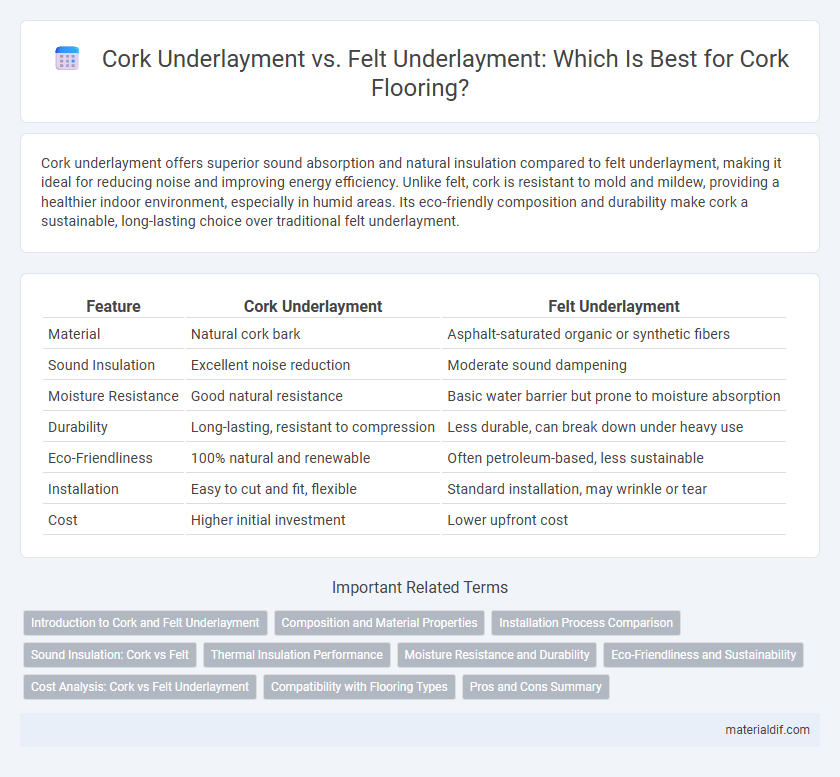Cork underlayment offers superior sound absorption and natural insulation compared to felt underlayment, making it ideal for reducing noise and improving energy efficiency. Unlike felt, cork is resistant to mold and mildew, providing a healthier indoor environment, especially in humid areas. Its eco-friendly composition and durability make cork a sustainable, long-lasting choice over traditional felt underlayment.
Table of Comparison
| Feature | Cork Underlayment | Felt Underlayment |
|---|---|---|
| Material | Natural cork bark | Asphalt-saturated organic or synthetic fibers |
| Sound Insulation | Excellent noise reduction | Moderate sound dampening |
| Moisture Resistance | Good natural resistance | Basic water barrier but prone to moisture absorption |
| Durability | Long-lasting, resistant to compression | Less durable, can break down under heavy use |
| Eco-Friendliness | 100% natural and renewable | Often petroleum-based, less sustainable |
| Installation | Easy to cut and fit, flexible | Standard installation, may wrinkle or tear |
| Cost | Higher initial investment | Lower upfront cost |
Introduction to Cork and Felt Underlayment
Cork underlayment, made from natural cork tree bark, offers superior thermal insulation, soundproofing, and moisture resistance compared to traditional felt underlayment. Felt underlayment, typically composed of asphalt-saturated organic or synthetic fibers, provides a cost-effective moisture barrier but lacks the eco-friendly benefits and cushioning properties of cork. Both materials serve as underlayments in flooring and roofing applications, but cork's renewable nature and enhanced performance make it a preferred choice for sustainable construction projects.
Composition and Material Properties
Cork underlayment is made from natural cork granules compressed into sheets, offering excellent sound absorption, resilience, and moisture resistance due to its cellular structure. Felt underlayment is typically composed of asphalt-saturated organic fibers or synthetic materials, providing moderate cushioning and basic moisture protection but lower durability compared to cork. Cork's elasticity and natural antifungal properties make it superior for environments requiring both comfort and long-term performance, whereas felt is more prone to compression and degradation over time.
Installation Process Comparison
Cork underlayment offers a more straightforward installation process due to its lightweight, flexible sheets that conform easily to subfloor irregularities, requiring minimal acclimation time. Felt underlayment involves a more labor-intensive procedure, often needing adhesive application or stapling and proper alignment to avoid wrinkles and gaps, which can extend installation duration. Both materials require careful subfloor preparation, but cork generally allows for quicker, cleaner installation with fewer tools and less mess.
Sound Insulation: Cork vs Felt
Cork underlayment provides superior sound insulation compared to felt underlayment due to its natural cellular structure, which effectively absorbs impact and airborne noise. Felt underlayment offers basic sound dampening but lacks the density and resilience found in cork, resulting in less effective noise reduction. For projects prioritizing acoustic performance, cork underlayment significantly enhances soundproofing in residential and commercial flooring installations.
Thermal Insulation Performance
Cork underlayment offers superior thermal insulation compared to traditional felt underlayment due to its natural cellular structure, which traps air and reduces heat transfer. This eco-friendly material maintains indoor temperatures more effectively, enhancing energy efficiency in both residential and commercial buildings. Felt underlayment provides basic insulation but lacks the thermal resistance and moisture-wicking properties inherent in cork, making cork the preferred choice for optimal thermal performance.
Moisture Resistance and Durability
Cork underlayment offers superior moisture resistance compared to felt underlayment, making it an excellent choice for areas prone to humidity and spills. Its natural cellular structure not only repels water but also provides enhanced durability, resisting wear and compression over time. Felt underlayment, while cost-effective, tends to absorb moisture and deteriorate faster, reducing its lifespan and effectiveness under flooring.
Eco-Friendliness and Sustainability
Cork underlayment is highly eco-friendly, made from renewable cork oak bark, which is harvested without harming the tree, promoting sustainability. In contrast, felt underlayment often relies on petroleum-based products, making it less sustainable and environmentally damaging. Cork's natural biodegradability and superior insulation properties enhance its appeal as a green building material compared to traditional felt options.
Cost Analysis: Cork vs Felt Underlayment
Cork underlayment typically costs between $0.75 and $1.50 per square foot, offering superior sound insulation and durability compared to felt underlayment, which ranges from $0.20 to $0.35 per square foot. While felt underlayment is more budget-friendly initially, cork's longer lifespan and moisture resistance can result in lower maintenance and replacement costs over time. Investing in cork underlayment provides better long-term value in residential and commercial flooring projects due to its enhanced performance and eco-friendly properties.
Compatibility with Flooring Types
Cork underlayment offers excellent compatibility with hardwood, laminate, and engineered wood floors due to its natural cushioning and moisture-resistant properties. Felt underlayment works well with vinyl and carpet flooring but may not provide adequate moisture protection for wood-based floors. Choosing cork enhances sound insulation and durability across various flooring types, while felt is better suited for softer, less moisture-sensitive floor coverings.
Pros and Cons Summary
Cork underlayment offers superior sound insulation, natural mold resistance, and eco-friendly benefits, making it ideal for reducing noise and improving indoor air quality in Cork homes. Felt underlayment is more affordable and provides good moisture resistance but lacks the same durability and environmental advantages as cork. While cork can be more expensive upfront, its longevity and sustainable properties often justify the investment compared to traditional felt underlayment.
cork underlayment vs felt underlayment Infographic

 materialdif.com
materialdif.com